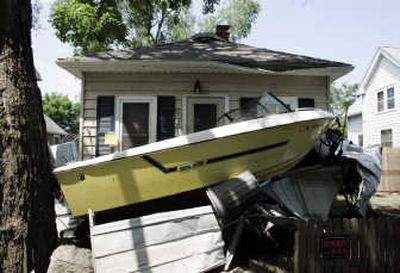Amid ruin, Iowa town begins flood cleanup

CEDAR RAPIDS, Iowa – Marc Holley was among the last residents allowed to return home to Cedar Rapids, Iowa’s hardest hit neighborhood, where flooding reached roofs. The water ruined everything on his first floor, rearranging furniture and leaving behind mud, mold and a thick stench.
“The smell is almost like a rotting corpse. It’s been festering for more than a week,” he said Friday. “I almost wish it had been a tornado instead, so we could sift through everything and just start over.”
Many of his neighbors agreed their homes would never be the same.
The most widespread damage from flooding across the Midwest this month occurred in this eastern Iowa city. At least 10,000 people were evacuated in low-lying areas, and city officials prevented many of them from going home until now because of safety concerns.
Thousands of stunned families have returned over the past few days to scenes reminiscent of New Orleans after Hurricane Katrina. The neighborhoods were empty and quiet, huge slices of the city remained without power, and National Guard troops enforced a nighttime curfew to maintain order.
The downtown streets looked ransacked, as if some giant drawer had been upended, its contents shaken out and then dragged through the mud. Out-of-state disaster response trucks arrived to clean flooded hotels, banks and city buildings there.
Meanwhile, service centers opened to lead residents through the maze of applying for aid with the Federal Emergency Management Agency. Shelters provided thousands of free meals, and residents looked for rental housing.
Police officers arrived from Minnesota and Nebraska to deliver bottled water and cleaning supplies. Community meetings were scheduled in each neighborhood to inform residents of their options.
“Right now, we’re just at the recovery and cleanup point,” said city spokesman Dave Koch. “We’re not to rebuilding yet.”
Cedar Rapids police said looting was not widespread in the flood damaged areas, but they did arrest one woman on Thursday for stealing alcohol and other items from a local bar.
City inspectors were checking almost 1,000 homes each day for structural damage, but they hadn’t reached some neighborhoods. Authorities said the majority of homes got the yellow placards, which means a building received some damage and had to be inspected by an electrician before power is restored.
As residents return home, civic leaders are planning for the future. Even before the floodwaters completely receded, a delegation hopped on a private jet and flew to Grand Forks, N.D., which had flooded in 1997. Grand Forks offered a hopeful model: A similar-size city, hit by a devastating flood that took out 60,000 homes, had bounced back remarkably well and resumed a trajectory of civic growth.
Downtown merchants and business people know they must move quickly to re-establish themselves. Smulekoff’s, a landmark furniture store on the west bank, suffered severe damage and lost showroom inventory. Floodwaters topped the stage at the landmark Paramount Theatre, which the city had refurbished, and at the Cedar Rapids Symphony’s orchestra hall.
Outside of downtown, other institutions are facing their own wrenching cleanup chores. Before the flood hit, workers at the city’s Czech Museum scrambled to move its trove of immigrant heritage to safety, but floodwaters still ravaged the library, ruining historic artifacts and documents and destroying several of the museum’s most valued displays.
Late last week, preservationists from the Chicago Conservation Center carefully picked through folk costumes and other textiles, tenderly rinsing them with clean water and vacuuming them dry. Others sorted through drenched, delicate documents, preparing to freeze them for the trip to Chicago for further preservation efforts.
Gail Naughton, president of the Czech Museum, said the Czech and Slovak governments already have contacted the museum, promising to send new material for its displays. Many others have contacted the museum and offered support.
“There really is a sense of family out there,” Naughton said. “It gives me hope, hope to rebuild.”